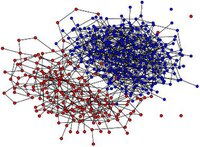
Photo from wikipedia
The voter model is a simple agent-based model to mimic opinion dynamics in social networks: a randomly chosen agent adopts the opinion of a randomly chosen neighbour. This process is… Click to show full abstract
The voter model is a simple agent-based model to mimic opinion dynamics in social networks: a randomly chosen agent adopts the opinion of a randomly chosen neighbour. This process is repeated until a consensus emerges. Although the basic voter model is theoretically intriguing, it misses an important feature of real opinion dynamics: it does not distinguish between an agent's publicly expressed opinion and her inner conviction. A person may not feel comfortable declaring her conviction if her social circle appears to hold an opposing view. Here we introduce the Concealed Voter Model where we add a second, concealed layer of opinions to the public layer. If an agent's public and concealed opinions disagree, she can reconcile them by either publicly disclosing her previously secret point of view or by accepting her public opinion as inner conviction. We study a complete graph of agents who can choose from two opinions. We define a martingale $M$ that determines the probability of all agents eventually agreeing on a particular opinion. By analyzing the evolution of $M$ in the limit of a large number of agents, we derive the leading-order terms for the mean and standard deviation of the consensus time (i.e. the time needed until all opinions are identical). We thereby give a precise prediction by how much concealed opinions slow down a consensus.
Journal Title: Journal of Statistical Mechanics: Theory and Experiment
Year Published: 2018
Link to full text (if available)
Share on Social Media: Sign Up to like & get
recommendations!